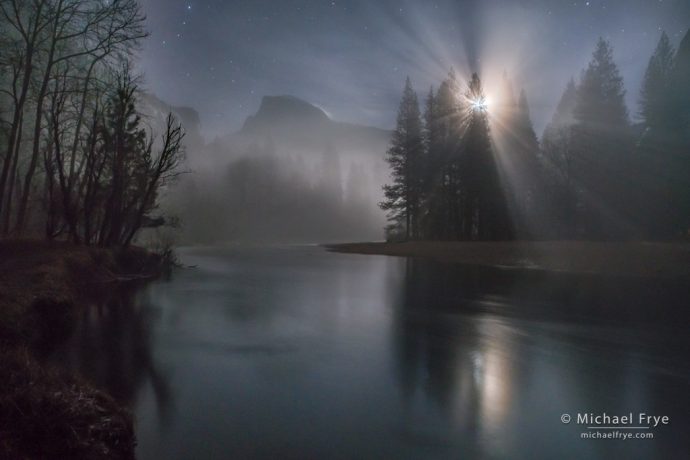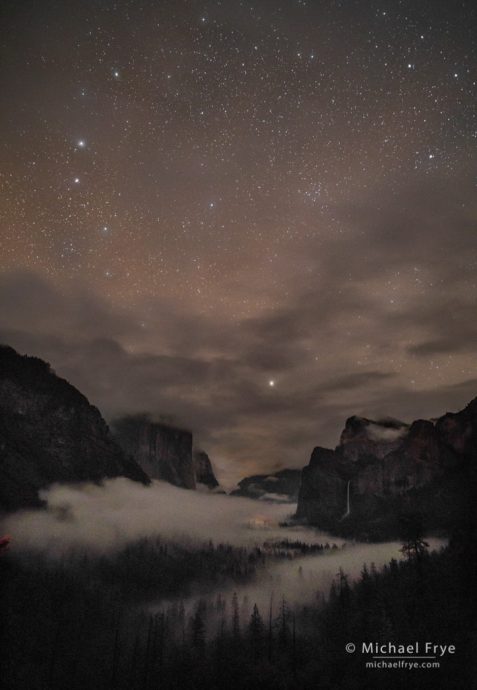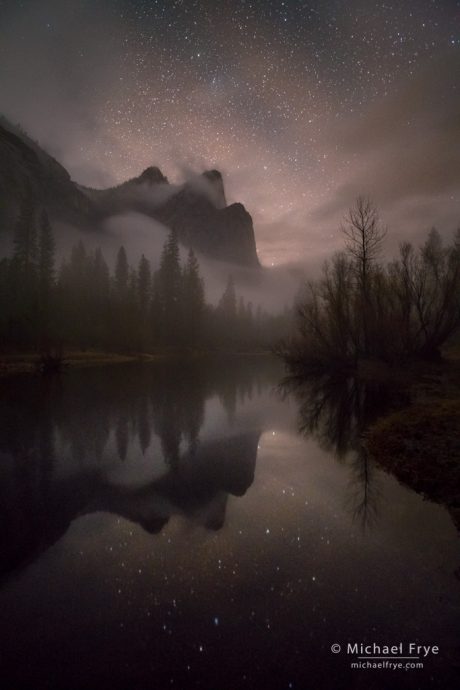We haven’t had much rain or snow this winter, but on Monday and Tuesday we finally got a decent storm. Though the storm wasn’t as big as initially predicted, Yosemite Valley got a good soaking, with an inch and a half of rain. No snow though, as it was very warm. (This same storm dumped much more rain on southern California, creating devastating mudslides. This state has endured a lot lately.)
On the few occasions when we’ve had precipitation this winter, I always seemed to have some commitment that prevented me from getting out to photograph. But this time I didn’t have any pressing deadlines, so I kept a close eye on the weather, hoping to get up to the valley to photograph the storm clearing.
Although the rain slowed down on Tuesday, the sunset didn’t look promising, as the satellite and radar images kept showing scattered showers and lots of cloud cover all afternoon. So it looked like the storm would clear during the night. That meant either heading up to the valley early the next morning, when there would be a good chance of finding some lingering mist, or driving up to the valley in the dark to photograph the storm clearing at night. The moon would be 35% full, and due to rise at 1:33 a.m. That seemed like good timing, and 35% full was just about right: bright enough to have a clear effect, but dim enough to reveal lots of stars in the sky.
I packed my camera gear, some snacks, warm clothes, and a sleeping bag (for napping in the car), and arrived in the valley around 11:30 p.m. Just after I arrived it started raining again. Time for a nap.
I woke about 1:00 a.m. It had stopped raining, and some stars were visible. I headed to Tunnel View, as I thought that might be a good to see the moonight starting to illuminate the clouds. The moonlight, however, seemed to be blocked by clouds further east. But the skies kept clearing, and I was able to photograph stars over the misty valley:
As the skies cleared, the mist increased, rising up to fill most of the valley, and obscuring the valley floor. I decided to drive down to a favorite location along the Merced River, where I caught the Three Brothers wrapped in mist, with stars above, before the fog closed in again:
Time to move once more. In Cook’s Meadow I finally saw the moon itself, rising through the mist between Half Dome and Glacier Point. I decided to head to a spot along the river with a view of Half Dome, where I might be able to hide the moon behind a tree to prevent flare. With some luck I might even see some moonbeams.
But when I arrived at the spot the fog was thick, and I couldn’t see Half Dome or Glacier Point. I took some photos of misty trees backlit by the moon, and waited. It seemed unlikely that Half Dome would appear, but there was always a chance. In the meantime I dialed in the exposure for the moon.
And then I saw something. Is that part of Half Dome? It seemed to be. I changed my camera position to put the constantly-moving moon behind a tree, adjusted my composition, and sure enough, Half Dome started to emerge from the mist. And I could clearly see beams radiating out from behind the tree. I took one horizontal frame, then flipped the camera sideways and captured several panorama sequences. But in the end I liked the composition and moonbeams best in that first frame (shown at the top of the post).
Needless to say, I didn’t get much sleep Tuesday night, but I had a great time. I’m glad we finally got some rain, and I had a chance to photograph a clearing storm – the first one this winter!
— Michael Frye
P.S. For the Tunnel View photograph I used my typical settings for the stars and Milky Way (20 seconds at f/2.5, 6400 ISO). For the Three Brothers image I lengthened the exposure to 30 seconds and opened up the aperture to f/1.8 to get more detail in the foreground and reflection.
For the photograph of Half Dome at the top of the post, I gauged the exposure by using the blinkies (highlight alert). For a daytime image with the sun behind a tree I want to see some small blinkies in and around the sun, but not see the whole sky blinking at me. In that situation, with the sun in the frame, seeing no blinkies means the photograph is too dark, while seeing lots of blinkies means the image is overexposed.
I did the exact same thing with the moon behind a tree: found an exposure with small blinkies in and around the moon, but no more than that. I wasn’t trying to get detail in the moon itself, as that would make everything else way too dark. But I did want to preserve detail in the moonbeams, and the corona around the moon. The settings turned out to be 15 seconds at f/4, 1600 ISO.
With almost any landscape photograph, the most important exposure consideration is getting the highlights right, which I did. But in hindsight I probably should have made a lighter exposure to blend with this one, as I had to brighten the shadows considerably, which brought out a lot of noise. But I was in a hurry to try and capture a wider panorama, so I just made the one exposure, and luckily was able to eliminate most of the noise in software.
Related Posts: Moonrise from Valley View; A Clearing Storm by Starlight; A Clearing Storm by Moonlight
Michael Frye is a professional photographer specializing in landscapes and nature. He is the author or principal photographer of The Photographer’s Guide to Yosemite, Yosemite Meditations, Yosemite Meditations for Women, Yosemite Meditations for Adventurers, and Digital Landscape Photography: In the Footsteps of Ansel Adams and the Great Masters. He has also written three eBooks: Light & Land: Landscapes in the Digital Darkroom, Exposure for Outdoor Photography, and Landscapes in Lightroom: The Essential Step-by-Step Guide. Michael has written numerous magazine articles on the art and technique of photography, and his images have been published in over thirty countries around the world. Michael has lived either in or near Yosemite National Park since 1983, currently residing just outside the park in Mariposa, California.












Your photos make me want to be in Yosemite. I am homesick for the park. Thank you for sharing
Michael, those are spectacular. I’m glad you didn’t get caught napping (in more ways than one :-))
Are those locations along the Merced in the App? Also, I’m tripod shopping (again) and wondering what tripod you use for those long exposure shots.
Thank you again for all the sharing you do on this blog.
Thank you John. The location is in the app if you read carefully. I actually used my super-light ProMaster hiking tripod for these images, as the ballhead for my heavier Gitzo tripod is malfunctioning.
Thanks Michael. That’s impressive for such a light tripod. Can I ask what model of Gitzo you use?
You images blow me away. I have always admired your talent for balancing light with eloquent design.
Thank you Clement. To me, light and composition are intimately related. You can’t compose a photograph without considering the light. But interesting light won’t work without finding a way to incorporate it into a cohesive composition.
Great shots, especially the Half Dome image. Congratulations.
Again, you have started out with a bang for the new year! Will be hard to top the misty moonrise over Half Dome. Well worth staying up all night for! Congrats on your perseverance!
Perfection with the misty moonrise! Lucky you. Good way to start the new year! Congrats!
Thanks so much everyone – I appreciate the kind words!
These are wonderful photographs! Someone shared the top one on facebook. Glad he did, so I can come and see more of your work.
Lovely images, Michael, thanks so much. I love the moodiness of the images; the stars and the mist, along with the moonlight, create some beautiful muted colors. Really stunning.
Just sublime Michael. Wonderful. I appreciate that you provide commentary around your trips and thoughts as well as your camera settings and methodologies. Thank you!
What a fantastic series of images you made and all in one night! Your dedication and creative approach to your art is amazing Michael. You are an inspiration to all of us landscape photographers. As noted above, you have started off this year with a bang.
Fabulous images Michael!! As always, thank you for the behind the scenes information. One piece seemed to be missing….what lens were you using?? I noticed you were shooting wider than 2.8, so was just curious? Sure wish I lived on the West Coast and not the East! Love, love, LOVE your stories and the images you post!
Nice images and I am waiting for snow too….I am curious about night images myself and DOF or lack thereof. I might know the answer but will ask anyway? At F2.8-24mm Fuji XT-2 (the fastest lens which I have…which Lens were you using, please?) there is very little DOF. If the focus point is foreground then the background is out of focus and the opposite. So do you blend to have the whole image in focus or just accept that one or the other will be out of focus? At 1.8 you have minimal DOF but more light. It Seems like night photography is a series of compromises as is all photography, which do I want in focus, foreground, midground or background unless you blend. But that is photography, you need to choose your focus and exposure priorities. Thanks
The combination of mist and stars is very beautiful. I want something like this in my photography as well. Thanks for the inspiration.
Thank you very much for posting your photos and especially your comments. I study your photos and carefully read your comments and then try to imagine how I might improve the image. Almost always, my conclusion is that they are not improvable. I love that you provide the technical details and tell WHY you did what you did. I feel like every time I read one of these posts, I become a tiny bit better as a photographer- if only I can remember to APPLY what I learned
Michael,
Your photographs are undeniably beautiful and technically outstanding. Obviously the result of talent, experience, dedication and lots of (often sleep deprived) work. But what really strikes me is the stories that accompany them. A picture may be worth a thousand words but your few sentences bring the viewer deeper into the landscape.
Jim
Stunning as always, very envious of where you live Michael! Take care!
All of the above! Thanks for sharing images and words.
Michael,
Stunning, the two star images in particular! Reminds me of January of last year, but without all the snow.
Cheers to you,
Alyn
Wonderful images, Michael. What software do you use for noise reduction?
Thanks Bill. Once in awhile I try Topaz Denoise, but mostly I use Lightroom, which is what I did with these. I’d rather apply noise reduction to the raw data, and Lightroom allows me to apply sharpening and noise reduction selectively. The new Range Mask tool is a help with this, as I can use it to apply noise reduction and/or reduced sharpening to just the shadows, or just the shadows in part of the image. The Masking slider is also quite helpful for applying sharpening selectively.
Thanks for the information on noise reduction etc.
***Sigh*** All of these photos you so painstakingly captured are exquisite, spiritual. The misty moon looks like someone flipped on a light switch. My appreciation for your stunning works is immeasurable.
Thanks again everyone! I really appreciate all the comments, and I’m glad so many of you like these images.
Those images are magical, Michael! A balm for the soul.
Michael…when you spoke of noise reduction in LR/sharpening, does you LR course cover that
Yes it does, including a video about noise reduction.
Michael, looks like you’ve got a running start on your list for us to vote on at the end of the year.
If you find yourself with nothing to write about one day, perhaps you’d mention the apps you use for your live weather tracking. So far my trials have been errors. Thanks, from under-snowed Colorado.
I love the images and I love it when effort pays off! Thanks for sharing.